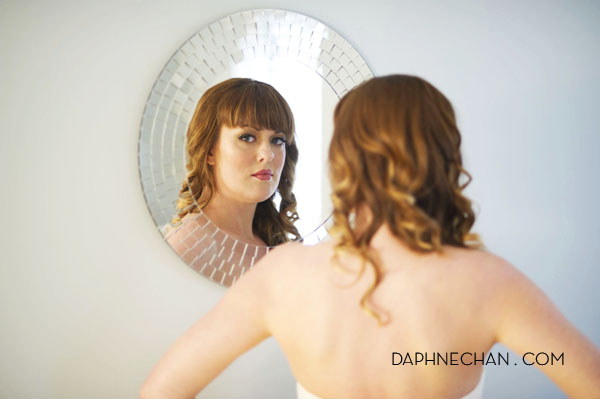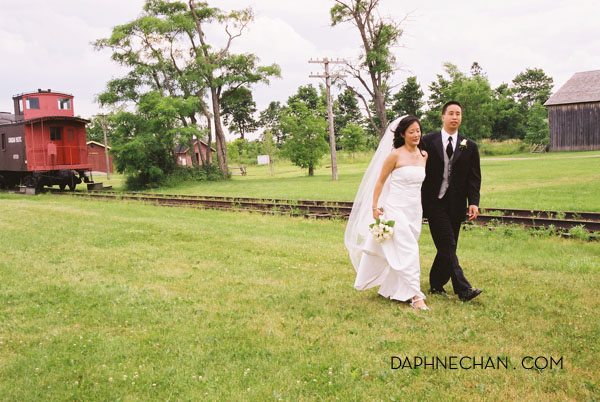Anyone who wants to venture into the realm of professional photography has to master their first wedding. Wedding photography can be a challenging and rewarding experience but get it wrong and you are in trouble. Daphne Chan takes us through her ten tips for your first wedding shoot.

1. Preparation is key
Know your equipment well and practice using it before the big day. Make sure all your gear is in working order and check it again the night before. Ensure you have back-up equipment of everything including another camera body and extra lenses, memory cards, batteries and flashes. If you don’t own all this equipment yet, borrow (or beg) from another photographer or rent. Many rental places will only charge you for one day if you rent from Friday evening to Monday morning.
2. Scouting location
If you have never photographed, or even been to, the ceremony or reception location, consider scouting the location. Try to view the venue at the same time the wedding is scheduled for and observe the lighting conditions available.
3. Rehearsal
If you have the opportunity, ask to attend the rehearsal. It will give you the opportunity to meet the officiant, learn how long the ceremony is and watch how it will proceed. If the ceremony is culturally different from what you’re familiar with, this is especially important. Attending the rehearsal will also give you a chance to introduce yourself to the bridal party and family members and establish a comfortable relationship.
4. Punctuality
There’s nothing more nerve-wracking for a bride (and groom) than a photographer who is late. On the wedding day, whether you’re starting at the bride’s home or the ceremony location, arrive early. It will give you time to set-up your equipment and examine the rooms or venue for flattering window light and other good portrait locations.
5. The ceremony
Speak to the couple or the officiant and ask about any photography restrictions during the ceremony. For example, if you’re not permitted to use flash you may need to use a tripod or a higher ISO setting or a lens with a wide aperture. If you’re only allowed to stand in one spot during the ceremony, you may need a longer lens to make sure you capture close-ups of the couple. The two key moments of the ceremony that often happen very quickly is the kiss and the recessional so be prepared to be in the right spot to capture those moments.

6. Formal portraits
Schedule adequate time for the formal portrait session. If the formals are outside, have a “in case of rain” alternate location picked out. Find out if the location requires a permit for photography and, if so, ask the couple if they have one.
7. Shot list
Try to pre-visualize the day and map out the required photos for each section of the wedding day. You can also request from the bride or groom a list of the bridal party members. The maid of honour is a key member of the bridal party and can often help you organize and identify the family members during the formal portraits.
8. Schedule
About 4-6 weeks from the wedding date, request a copy of the wedding day schedule from the couple. Review the schedule and check that there’s enough of a time buffer built in to account for typical delays on the wedding day.
9. Lighting
With the exception of outdoor weddings, where the ceremony and reception are in the same location, and you benefit from using natural light, at some point you will be photographing indoors. When indoors, be prepared to deal with low and mixed lighting situations. For light sources, you can use flash, strobe and even video lights.
10. Assist or second shoot at another wedding
My biggest and final tip is to get as much experience as you can before you first shoot your own wedding assignment. Try to assist or second shoot for at least one wedding and at least one photographer. Better yet, assist different wedding photographers and you can learn from their style and approach to a wedding day. In addition, strongly consider hiring an assistant or a second shooter on the day of your first wedding.
Good luck!
http://www.daphnechan.com/
http://daphnechanblog.com/
Twitter
Facebook
I would add a few additional useful points:
1. regarding the shot list – have the couple assign 1 person (not the bride or groom) to bring the people to you for formal portraits. There is almost always less time than planned – or the light is fading – the photographer or their assistant should not be rushing around trying to find Aunt Betty from the bride’s side. I’ve also had family members approach me because they thought they should be in a certain portrait…it’s great to have the list and someone else responsible to explain these things to their guests.
2. I try to let the person above plus B&G aware that when I’m shooting formal portraits the other guests cannot be shooting next to me – it’s so incredibly frustrating when they are looking into the camera 2′ to my side instead of in my shot… or worse when the person standing next to me comes up with a pop up flash and I get a streak of light in the image. I also put this in my contract – that I’m not responsible for ruined images due to other’s flashes going off or someone suddenly walking in front of the camera, etc. I shoot mostly documentary style so I already have the occasional elbow thrust into the shot last second, this is normal and part of the process..but for formal portraits there should be some level of control.
3. Be very clear and honest about your timing to produce the final images – this should be set in advance… processing time can take many full days…if you’re already booked for other weddings or you have a full time job, space out the processing over several weeks. The B&G should also never expect to get “every” photo you shot at the wedding/reception. A pro photographer gives the best photos only – you don’t want your name on a bad photo out on the internet -ever…because sure enough one day when you are really hoping for that dream assignment, they will google your name and that darn bad photo will be the first to pop up!
4. weddings/receptions go really quickly! be sure to have a few shots already planned out – especially if the B&G have requested a certain style – but also give them a little of your personal style in addition to what they are expecting. Peruse online sites from photographers you like – check out other ideas for portraits, details (don’t forget the details…a 2nd shooter is excellent for this), framing, composition, etc. Many sites like photo.net have the camera data for each image so you can see the settings. Ideas always come from somewhere… have a look at what others are doing and then add your personal touch.
5. dress professionally for the wedding. I prefer to blend into the backdrop and not call attention to myself…I find a pair of black pants (that are easy to move, bend, crouch, etc in) and a black T-shirt with my company logo discreetly on the sleeve is best. My assistants also wear the same. You can have shirts made with your logo on cafe press or similar. When I first started out I had lots of bags of equipment, stands, etc. I used iron-on transfers to put my company logo on all my bags, duffels, etc. It makes a very positive impression when you look put together and like you know what you’re doing 😉
Great list but I must say that bending the rules is sometimes advisory. Not always but when you get some experience skipping point 2 can bring some great results. Coming into the wedding with fresh start without actually preparing for specific shots can get great results. Be open to new possibilities, but be sure to get what bride wants. She is the one on the day – not you.
Hi Daphne, came across this page via a tweet this morning.
Some great tips here but I would recommend anyone photographer wanting to photograph weddings to follow your number 10 tip first.
Go to a wedding with an experienced photographer, assist them, observe and learn how they shoot the wedding, how they handle the various parts of the day, what equipment they use, how they handle difficulties if they arise.
Once you have been to a few weddings as an assistant, if possible with more than on photographer, then you get a feel of what to expect when you shooting your first wedding on your own.